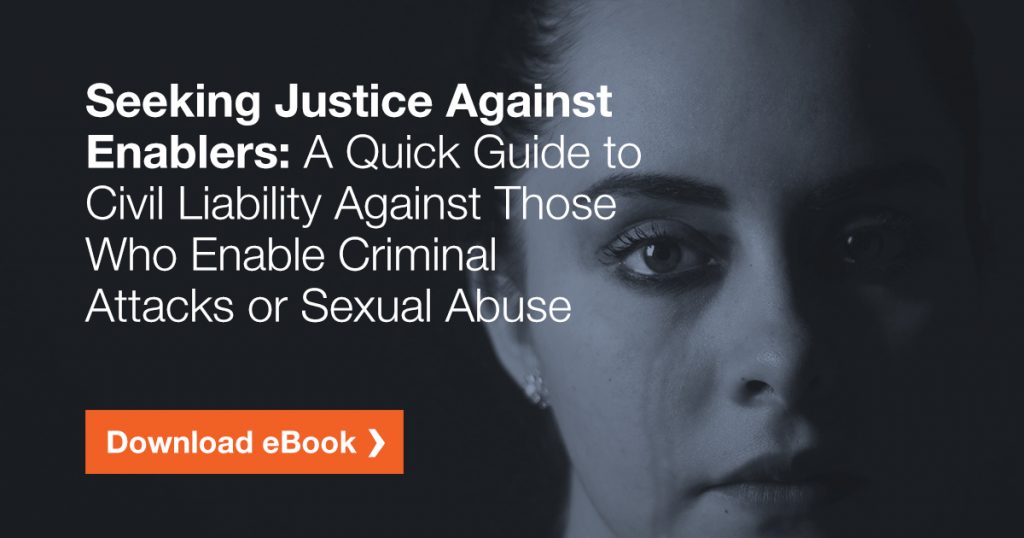Introduction
Have you or a loved one recently been the victim of an attack, bullying or abuse? Have you or a loved one incurred medical bills or lost time at work while dealing with injuries or the psychological impact from such attack, bullying or abuse? Are you considering seeking compensation for the injuries or psychological damage inflicted by an assailant? Are you simply interested in learning more about this area of the law? If so, read on.
Core Liability Theories and Defenses
Following an attack, bullying or abuse, the natural tendency is to consider the assailant the target defendant. Indeed, first year law students learn that the assailant is potentially liable for
damages for assault and battery. So why shouldn’t the discussion end there? Because many assailants will end up in prison and therefore penniless. Even if the assailant has some form of liability insurance, most liability policies exclude intentional conduct like assault and battery. Often, plaintiff’s lawyers have tried to get around this problem by arguing that the assailant didn’t act intentionally because he or she was too intoxicated to know better. I used to make those arguments too, but insurance companies began rewriting their policies in a way that made it virtually impossible to collect against them for any assault.
Many situations involving a criminal attack or some form of abuse were enabled by another person or business. These enablers can take multiple forms, depending on the circumstances. In the sections below we will look at a few examples.
For the moment, let’s consider the primary legal theories subjecting the enabler to liability for the assailant’s acts: negligence and breach of fiduciary duty. Negligence is a failure to act when one had a duty to act and was on notice in some way about the assailant’s potential to do harm. But there is an important catch: If your case is based on negligence, Florida recognizes a defense known as the “impact rule.” This requires the plaintiff to show the assailant was physically (versus only verbally) abusive. Stated differently, if there is no touching, there is no negligence case against the enabler. The law also recognizes the potential for liability for breach of fiduciary duty. This requires a higher duty of care and is applicable to persons caring for those with limited mental capacity, children or the elderly.
In addition to the impact rule, there is another important defense to consider. In virtually all negligence cases, a defendant will argue that the plaintiff was “comparatively negligent.” This means the defense will argue that the victim caused or contributed to his or her own injuries in some way. There are many other available defenses, but these are the most frequently-asserted ones.
This discussion would not be complete without mentioning that there are also potential statutory claims that may not require impact that may be made in addition to a negligence claim. An example is that a “hostile environment” existed because of verbal abuse coupled with racially or sexually charged gestures. This is especially relevant in the employment and school setting.
Common Types of Enabler Claims
The scope of enabler liability is best understood by illustration. The following are some of the more common scenarios…
Employers
Employers whose employees injure other persons may be liable for negligent hiring or retention of the assailant. Companies should perform background checks before hiring. Such checks may reveal a violent or otherwise questionable background. After hiring, companies should monitor their employees, particularly if aggressive or erratic behavior occurs. If the assailant was a co-employee, then employment law protections like Title VII would apply.
Case Examples
Firm member Marcus Castillo has handled negligent hiring and retention cases involving…
Sexual assaults
Injuries sustained inside a bar
Injuries at an office party
A frisk of a co-employee who was wrongfully accused of theft
Youth Organizations
Think of the responsibility of youth organization leaders as similar to employers. These organizations and their insurance carriers may be liable if supervisors knew about the assailant’s
dangerous tendencies but took no action. Many of these organizations carry liability insurance coverage.
Case Study
Our firm recovered a settlement from a youth organization when one of its youth leaders attempted to molest a camp attendee.
Government
Most state governments like Florida administer foster care programs. The vast majority of employees are dedicated public servants. Unfortunately, there are a handful of sexual predators
in their midst that have inflicted sexual abuse on foster children. The government may be liable in some instances if its supervisory employees knew or should have known about the abuse or assaults but took no steps to stop it.
Case Study
Firm member Marcus Castillo’s first solo jury trial involved allegations of negligent supervision over a foster parent accused of sexually battering children in his care. The case ultimately settled during trial on favorable terms.
Schools
Schools are a special situation. School bullying and attacks are governed by Title IX under federal law. Title IX requires a showing that the bullying or attack was motivated in some way by one’s gender. With the rise in bullying, expect to see more school-based lawsuits.
More on Bullying
Bullying can take many forms, from the playground to school halls to social media platforms. Parents can play a major role in helping kids stand up to bullying. For more information, check out www.stopbullying.gov.
Afterword
We hope you’ve found this eBook useful to understand the basic issues in a case involving a criminal attack or sexual abuse or related conduct. These cases demand aggressive investigation and a thorough grasp of the controlling law. Look to an attorney with broad- based experience in this area of practice.



